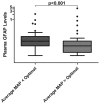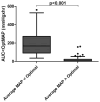Hypotension After Cardiac Operations Based on Autoregulation Monitoring Leads to Brain Cellular Injury
- PMID: 26089226
- PMCID: PMC4523452
- DOI: 10.1016/j.athoracsur.2015.03.036
Hypotension After Cardiac Operations Based on Autoregulation Monitoring Leads to Brain Cellular Injury
Abstract
Background: Individualizing blood pressure targets could improve organ perfusion compared with current practices. In this study we assess whether hypotension defined by cerebral autoregulation monitoring vs standard definitions is associated with elevation in the brain-specific injury biomarker glial fibrillary acidic protein plasma levels (GFAP).
Methods: Plasma GFAP levels were measured in 121 patients undergoing cardiac operations after anesthesia induction, at the conclusion of the operation, and on postoperative day 1. Cerebral autoregulation was monitored during the operation with the cerebral oximetry index, which correlates low-frequency changes in mean arterial pressure (MAP) and regional cerebral oxygen saturation. Blood pressure was recorded every 15 minutes in the intensive care unit. Hypotension was defined based on autoregulation data as an MAP below the optimal MAP (MAP at the lowest cerebral oximetry index) and based on standard definitions (systolic blood pressure decrement >20%, >30% from baseline, or <100 mm Hg, or both).
Results: MAP (mean ± standard deviation) in the intensive care unit was 74 ± 7.3 mm Hg; optimal MAP was 78 ± 12.8 mm Hg (p = 0.008). The incidence of hypotension varied from 22% to 37% based on standard definitions but occurred in 54% of patients based on the cerebral oximetry index (p < 0.001). There was no relationship between standard definitions of hypotension and plasma GFAP levels, but MAP of less than optimal was positively related with postoperative day 1 GFAP levels (coefficient, 1.77; 95% confidence interval, 1.27 to 2.48; p = 0.001) after adjusting for GFAP levels at the conclusion of the operation and low cardiac output syndrome.
Conclusions: Individualizing blood pressure management using cerebral autoregulation monitoring may better ensure brain perfusion than current practice.
Copyright © 2015 The Society of Thoracic Surgeons. Published by Elsevier Inc. All rights reserved.
Figures



Comment in
-
Invited Commentary.Ann Thorac Surg. 2015 Aug;100(2):493-4. doi: 10.1016/j.athoracsur.2015.05.053. Ann Thorac Surg. 2015. PMID: 26234835 No abstract available.
References
Publication types
MeSH terms
Substances
Grants and funding
LinkOut - more resources
Full Text Sources
Other Literature Sources
Medical
Miscellaneous


